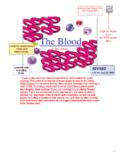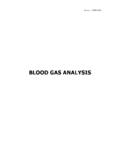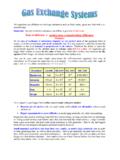Transcription of Arterial Blood Gas Interpretation: The Basics
1 ABG Basics : Page 1/10. Arterial Blood Gas interpretation : The Basics Author: David C Chung MD, FRCPC. Affiliation: The Chinese University of Hong Kong Sampling of Arterial Blood for Blood gas analysis will yield information on: Oxygenation of Blood through gas exchange in the lungs. Carbon dioxide (CO2) elimination through respiration. Acid-base balance or imbalance in extra-cellular fluid (ECF). Oxygenation A normal healthy person at rest consumes oxygen (O2) at a rate of approximately 4. ml/kg/min. This consumption can be increased 10 times in a moderately fit person and as much as 20 times in an Olympic class athlete during exercise. This oxygen is used in oxidative (aerobic) metabolism of carbohydrate and fat, the end product of which is water (H2O) and carbon dioxide (CO2). When oxygenation is inadequate to meet tissue needs, the condition is called hypoxia. In the presence of hypoxia, aerobic metabolism cannot proceed and the end product of anaerobic metabolism is lactic acid.
2 Acid, hydrogen ions, and pH. An acid is a hydrogen ion (H+) donor. Conversely an alkali is an H+ acceptor. The loss of 1 mmol of alkali is equivalent to the gain of 1 mmol of acid and vice versa. The acidity and alkalinity of a solution is measured by the pH scale. The pH of a solution is equal to the negative log of the hydrogen ion concentration in that solution: pH = - log [H+]. Thus pH is low when hydrogen ion concentration is high and vice versa. Arterial Blood pH is maintained normal at (range to ). When Arterial Blood pH. is < , the pH value is acidotic, the Blood is said to be acidemic, and the condition is called acidosis. When Arterial Blood pH is > , the pH value is alkalotic, the Blood is said to be alkalemic, and the condition is called alkalosis. CO2 as a source of H+ ions and its elimination As much as 15,000 20,000 mmol of CO2 is produced through oxidative metabolism per day.
3 CO2 is called a volatile acid because it can combine reversibly with H2O to yield a strongly acidic H+ ion and a weak basic bicarbonate ion (HCO3-) according to the following equation: CO2 + H2O H+ + HCO3- (1). Normally CO2 produced in this manner is eliminated by the lungs through respiration and there is no net gain of H+ ion by the body. ABG Basics : Page 2/10. When respiration and CO2 elimination are inadequate, the retained CO2 will drive equation (1). to the right and release more strongly acidic H+ ion. As a consequence Arterial Blood becomes more acidemic (pH falls below normal range) and the condition is called respiratory acidosis. With hyperventilation (ventilation increased above normal), more CO2 is eliminated and equation (1) is driven to the left with a fall in H+ ion concentration. As a consequence Arterial Blood becomes more alkalemic (pH rises above normal range) and the condition is called respiratory alkalosis.
4 Other sources of H+ ions Metabolism of dietary protein produces the non-volatile hydrochloric and sulfuric acids, and metabolism of ingested phosphate produces phosphoric acid. The normal H+ ion load from this source is approximately 1 mmol of H+ ions per kilogram of body weight per day. The daily H+ ion load from non-volatile acids may be increased through other processes. For example: o Anaerobic metabolism yielding lactic acid as the end product. o Incomplete oxidation of fatty acids. o Gastrointestinal loss of alkali through diarrhea (a loss of 1 mmol of alkali is equivalent to a gain of 1 mmol of acid). o Ingestion of acidifying compounds ( , NH4Cl). o Hyperalimentation. The daily H+ ion load from non-volatile acids may be decreased through some other processes. For example: o Loss of hydrochloric acid (HCl) in gastric secretions through vomiting or gastric suction. o Metabolism of vegetables and fruits in dietary intake produces alkali (a gain of 1 mmol of alkali is equivalent to a loss of 1 mmol of acid).
5 Renal excretion of H+ and HCO3- ions The kidneys play a pivotal role in acid-base balance. They excrete H+ ions in exchange of HCO3- ions when the H+ ion load rises above normal and retain H+ ions in exchange of HCO3- ions when the H+ ion load falls below normal. When excretion of H+ ions in exchange of HCO3- ions by the kidneys is not enough to eliminate the H+ ion load, H+ ion concentration rises above normal, HCO3- ion concentration falls below normal, Arterial Blood pH becomes more acidic, and the condition is called metabolic acidosis. When retention of H+ ions in exchange of HCO3- ions by the kidneys is not enough to maintain H+ ion concentration normal because of a low H+ ion load, H+ ion concentration falls below normal, HCO3- ion concentration rises above normal, and Arterial Blood pH. becomes more alkalemic. The condition is called metabolic alkalosis. ABG Basics : Page 3/10. Compensations In the presence of respiratory acidosis the kidneys compensate for the fall in pH by excreting H+ ions and retaining HCO3- ions.
6 As a result, pH rises towards normal and HCO3- concentration rises above normal. Renal compensation (also called metabolic compensation). to respiratory acidosis is a slow process. Compensation is not obvious for several hours and takes 4 days to complete. Even then compensation is not total and pH is never completely corrected to normal. In the presence of respiratory alkalosis the kidneys compensate for the increase in pH by retaining H+ ions and excreting HCO3- ions. As a result, pH falls towards normal and HCO3- concentration falls below normal. Again renal compensation to respiratory alkalosis is a slow process and the pH does not completely return to normal. In the presence of metabolic acidosis, ventilation of the lungs increases through stimulation of central chemoreptors (H+ ion receptors) in the medulla and peripheral chemoreceptors in the carotid and aortic bodies. Consequently PCO2 falls below normal, equation (1) is pushed towards the left and H+ ion concentration falls.
7 This respiratory compensation contributes to increase the acidic pH towards normal, but not completely. The respiratory system responds to metabolic acidosis quickly and predictably by hyperventilation, so much so that pure metabolic acidosis is seldom seen, except in patients who are mechanically ventilated with a fixed minute volume in the Intensive Care Unit or in debilitated patients whose respiratory muscles are too weak to cope with the increased workload of breathing. The respiratory response to metabolic alkalosis is hypoventilation. PCO2 rises above normal. Respiratory compensation to metabolic alkalosis is variable and unpredictable. It is unlikely that a conscious patient breathing spontaneously will hypoventilate to a PCO2 > kPa (55. mmHg) to compensate for metabolic alkalosis. A systematic approach to the interpretation of ABG results Step 1: Check the origin of the ABG results and make sure they belong to the patient you are about to review.
8 Check the name and identification number on the report against the patient's other records ( , identification bracelet). Attributing the results from another patient to the one you are about to review can cause confusion and cost you dearly in court if the consequence is medical misadventure. Step 2: Review the patient's clinical condition and the indication for the ABG examination. This information will help you to focus your attention. Step 3: Obtain previous results, if there is any, for comparison. In medical practice changes in findings are as important as findings at any discrete moment. Step 4: Check if the patient is breathing room air (21% oxygen) or an oxygen supplement. Note the oxygen concentration if it is an oxygen supplement. ABG Basics : Page 4/10. Step 5: Look at the PO2 and decide if hypoxia is present. Hypoxia Normal Hyperoxia PO2 <12 kPa 12 to 13 kPa >13 kPa (<90 mmHg) (90 to100 mmHg) (>100 mmHg).
9 SO2 <95% 95 100 %. In the International System of Units (SI Units), the unit of pressure measurement is pascal (Pa). kPa stands for kilopascal and equals 1,000 Pa. The pascal unit is meant to be used for all pressure measurements, including Blood pressure and gas tension like PO2 and PCO2. If the pascal unit is used for Blood pressure measurement, a normal Blood pressure of 120/80 mmHg would be an unwieldy 15960/10640 Pa. Therefore doctors around the world have agreed to retain mmHg as the unit of Blood pressure measurement. With respect to gas tension, there is no universal agreement. Some doctors use the pascal unit and others use mmHg. The conversion factors between kPa and mmHg are: o 1 atmosphere = 100 kPa = 760 mmHg o 1 kPa = mmHg o 1 mmHg = kPa. PO2 should be close to kPa or 100 mmHg in young healthy adults breathing room air (21% oxygen) at sea level. Due to an increase in V/Q mismatch, PO2 falls with age even when the individual is fit and healthy.
10 The following equation gives a reasonable estimation of PO2 (in mmHg) in patients older than 40 years: PO2 = 104 - (age x ) mmHg SO2 stands for oxygen saturation or percentage of hemoglobin combined with oxygen. In ABG results, SO2 is derived from PO2 using the oxygen-hemoglobin dissociation curve. It can also be measured using a pulse oximeter. SO2 may be as low as 90% in healthy patients of advanced age. Step 6: Look at the pH and decide whether its value is acidotic, normal, or alkalotic. Acidotic Normal Alkalotic pH < to > The pH is the best indicator of whether the underlying disorder is acidosis or alkalosis. Even when compensatory mechanisms are fully functional, by themselves, they cannot correct the underlying disturbance completely. Acidosis is more sinister than alkalosis. Very low Arterial Blood pH may be incompatible with life. A pH of is a dire sign requiring urgent action. ABG Basics : Page 5/10.





